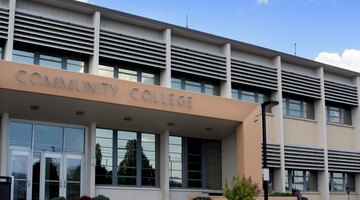Although it sounds too good to be true, free tuition at community colleges is a reality in some places in both the United States and abroad. For example, government programs such as the Tennessee Promise provide a scholarship to residents attending public community and technical schools in that state. The scholarship pays tuition and fees not covered by other sources of aid.
Tip
One of the biggest advantages of free tuition at community college is lower cost of attendance. Students have an easier time paying for books and living expenses if tuition is waived.
Offering free college tuition makes college accessible to all students, not just those with the means to pay for it. Certain countries like Germany, England and Scotland already waive tuition at public universities. Therefore, it is possible to make college free.
Should College Be Free?
If you are a high school student, you may think, "Of course college should be free!" Ending public education after grade 12 seems like an outdated notion in a digital age where future workers need knowledge and technical skills not taught in high school. College students would also have more time to study, participate in extracurricular activities, conduct research and study abroad if they didn’t have to work as much to pay for school.
On the flip side, students who pay their way through school may appreciate their education more and study harder than students awarded a free education. Working to pay for college provides students with real-world job experience. Recent college graduates with a strong work ethic appeal to hiring managers.
Benefits of Free College Education
Previous generations were less dependent on postsecondary training. Even young people who didn’t finish high school could make a living working in the trades, in industry or in agriculture. However, today’s high school graduates typically need some type of postsecondary education to survive.
Offering free college tuition could expand the middle class. The Georgetown University Center on Education and the Workforce (CEW) reported in 2018 that level of education correlates with increased annual income. According to CEW, workers with a high school diploma earn a median income of $36,000; whereas, bachelor degree holders earn a median income of $62,000 and professionals with a graduate degree earn $80,000.
Free tuition at community college would level the playing field for students seeking an education. Many students shy away from expensive schools because scholarships are highly competitive. Borrowing money for college can put students and their family co-signers deep in debt. Aversion to loan debt can dissuade a student from even considering postsecondary education.
Advantages of Free College Education
The Federal Reserve indicates that as of 2017, student loan debt exceeds 1.3 trillion dollars. First-generation students whose parents did not earn a college degree are more likely to fall behind on loan payments after leaving school.
Free tuition at public community colleges could bring relief to cash-strapped families who don’t qualify for grants or scholarships. By living at home, students could further reduce the amount they may need to borrow to pay for room and board in a dorm or for an apartment.
Educating the workforce would reduce the need for other public assistance programs. Workers with good jobs pay taxes and spend money that stimulates economic growth. Instead of making huge monthly student loan payments, college graduates could buy a car or save money for a down payment on a house.
Social Benefits of Free Tuition
The advantages of free tuition reach beyond individual students and their families. Society would prosper by tapping the talents of workers stuck in dead-end jobs due to lack of education. The Georgetown University Center for Education and the Workforce estimates that offering free college tuition to families annually earning less than $125,000 could increase enrollment at public universities by 9 to 22 percent. Enrollment at community colleges and technical schools could jump 13 to 31 percent.
Due to the cost of post secondary training, many high school graduates do not pursue a degree or certificate, which can have economic ramifications. Millennials without a college education are statistically more likely to be out of work and living with their parents than peers holding a college degree, according to the Pew Research Center in 2014.
Is Community College Worth It?
The value of college has long been debated. Countless individuals achieve fame and fortune through innovation and hard work, but more often, lack of education limits earning potential and affects quality of life. Major milestones like marriage, children and buying a house may need to be postponed by millennials saddled with student loans racked up at an expensive university or private school.
In contrast, attending community college is very affordable and offers a fast track to a good job. For example, the Bureau of Labor Statistics reports that dental hygienists, nuclear medical technologists and nurses with an associate degree can earn $70,000 or more. Along with acquiring practical skills, students pursuing an associate degree take general education classes intended to increase critical thinking and communication skills.
Possible Drawbacks of Free College
Along with the many benefits of free college tuition, there can be a downside. Weighing the pros and cons of free college education is important in any discussion of tuition and fee-waiver programs. Even students themselves have mixed opinions on the subject.
Ironically, college tuition programs can have unintended consequences and do little to help lower-income students. Tuition at community colleges is already reasonable, affordable and often covered by Pell Grants and state aid. According to a 2018 opinion piece in Forbes, offering free college tuition could potentially worsen the dropout rate because students would have less personal and financial investment in their education.
When free tuition is available at public schools, private schools must work harder to recruit students from all socioeconomic backgrounds. Private colleges may be forced to raise tuition to compensate for declining enrollment. Bright students from disadvantaged backgrounds may settle for a two-year education because it’s free instead of competing for scholarships at prestigious four-year universities. Consequentially, the diversity of students at elite schools, medical colleges and law schools may decline in states offering free college tuition at public institutions.
A formidable challenge to making college free to students is figuring out how to fund it. Liberal Senator Bernie Sanders suggests placing a tax on hedge fund traders, investment houses and other Wall Street speculators. A small tax on traded stock and bonds could offset the cost of free college tuition, boost the economy and strengthen the middle class, according to Sanders.
Moderate politicians have proposed increasing taxes on the upper middle class or reducing defense spending to help pay for education. As an alternative to free tuition, some conservative legislators believe that privatizing student loans would increase competition among lenders, resulting in better interest rates for student borrowers.
How to Lower College Costs
Many students and parents would like to see tuition lowered to make education more affordable. Legislators also keep an eye on rising tuition and fees to ensure that increases are justified. Colleges argue that declining state appropriations have forced them to raise tuition year after year. By increasing government funding to schools, tuition could be frozen or lowered, and fewer students would need financial aid to make ends meet.
Selective schools with high tuition offset that expense by offering generous scholarships to those who qualify. Loyal alums are a major contributor of scholarship dollars through individual and corporate donations. Public schools are also intensifying fund-raising efforts to reduce the cost of college to students.
Related Articles
References
- ProCon.org: Is a College Education Worth It?
- Pew Research Center: 6 Key Findings About Going to College
- Bureau of Labor Statistics: Radiation Therapists: Similar Occupations
- Tennessee State Government: Tennessee Promise Scholarship
- Federal Reserve System: Student Loan Debt and Aggregate Consumption Growth
- Inside Higher Ed: Clinton 'Free' Plan Would Swell College Enrollments
- The Hechinger Report: How Free College Tuition in One Country Exposes Unexpected Pros and Cons
- Georgetown University CEW: Median Earnings of $62,000 for College Graduates Nearly Twice Earnings of Workers With Only a High School Diploma, Says New Georgetown University Research
- USA Today: Here's how much Bernie Sanders' Free College for All Plan Would Cost
- Forbes: The Case Against Free College Tuition
Writer Bio
Dr. Mary Dowd is a dean of students whose job includes student conduct, leading the behavioral consultation team, crisis response, retention and the working with the veterans resource center. She enjoys helping parents and students solve problems through advising, teaching and writing online articles that appear on many sites. Dr. Dowd also contributes to scholarly books and journal articles.











